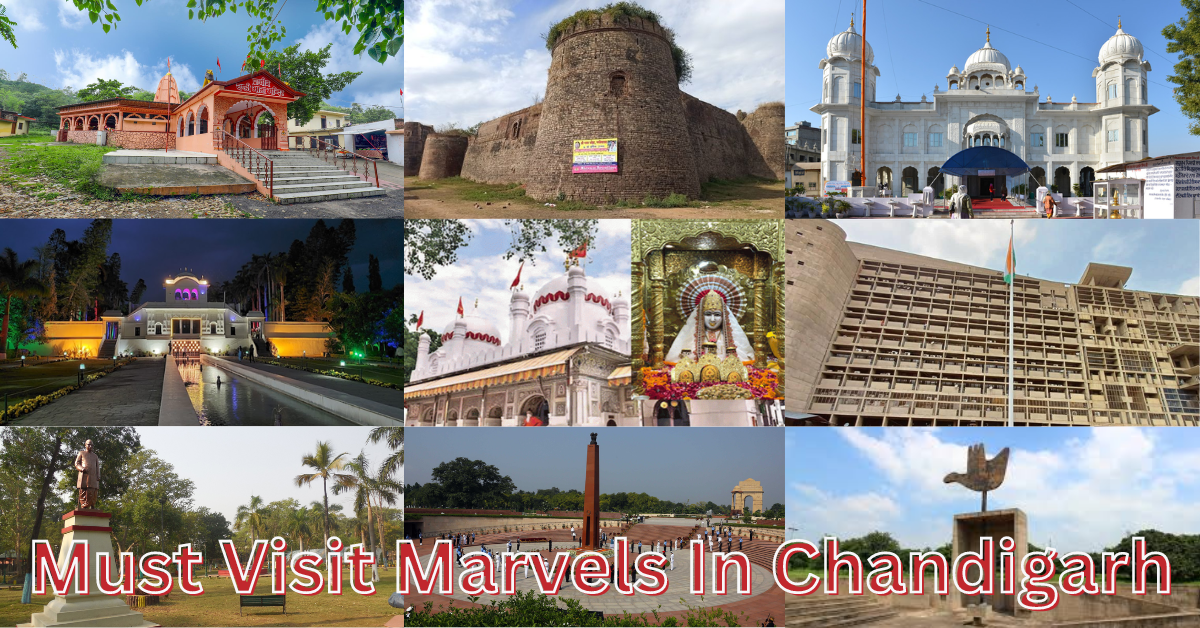Chandigarh stands as a majestic bridge, gracefully linking the tapestry of history with a vibrant canvas of modernity. Nestled within its architectural marvels and verdant landscapes lies a reservoir of tales, where the old intertwines with the new in an intricate dance of heritage and progress. This place is way more than a planned city; it is a living testament to the enduring spirit of human endeavor, where every edifice, every street corner, and every droplet of water tell a story. Follow this guide and indulge in the beauty of this city while transitioning from past to present.
1. Chandi Mandir:
A temple older than the city itself. Chandigarh draws its name from the ancient temple Chandi-garh, which means ‘fort of Chandi’ a goddess of power in the Hindu religion. According to legends, it is one of the Shakti Peetha( devotional shrines where severed body parts of goddess Sati Fell).
Ensconced amidst the scenic beauty of the Shivalik Hills, devotees can offer prayers and partake in blessings bestowed by the goddess along with panoramic views of the surrounding landscape from atop the hill
2. Manimajra Fort (1664):
With a history spanning over 360 years, Manimajra Fort is located in the town of Manimajra and was built by Ghareeb Dass Dhillon, this fort served as the capital of his newly formed state encompassing 84 villages.
Though the condition of the fort does not get it involved in the most splendid forts, but this fort recently gained popularity among tourists and history buffs after being featured in the Oscar-nominated Hollywood movies, Zero Dark Thirty
3. Nada Sahib(1688):
Nada Sahib holds profound significance in the hearts of Sikhs. Its historical roots trace back to the year 1688, a pivotal moment after the battle of Bhangani when Guru Gobind Singh and his followers sought respite at this site during their journey to Anandpur Sahib
The Gurudwara complex houses a serene Sarovar (holy pool) and a magnificent langar hall(community kitchen) that serves free meals to all visitors. Immerse yourself in the spiritual atmosphere and learn about the Sikh faith’s principles of equality and service at this historical pilgrimage site.
4. Yadavindra/ Pinjore Garden(17th Century):
Nestled in the foothills of the Himalayas, approximately 17 Kilometers from Chandigarh, lies Pinjore Garden. Built by the Mughal emperor Aurangzeb in the 17th century, this terraced garden is a delightful example of Mughal landscape artistry. Stroll through the manicured gardens adorned with fountains, pavilions, and sculptures spread across 100 acres, and immerse yourself in the serene beauty of the Mughal marvel
5. Shri Mata Mansa Devi (1811–1815 A.D.):
Dedicated to Goddess Mansa Devi, the Shri Mata Mansa Devi Temple is a popular pilgrimage site located atop the Shivalik Hills. Spanning over 100 acres, this sacred pilgrimage site traces its roots back to the 19th century, when Maharaja Gopal Das Singh of Manimajra constructed the present temple. This sanctified abode holds profound significance as one of the esteemed Shakti Peethas in North India.
6. Chandigarh Capitol Complex (1950):
Established in the 1950s and declared as a UNESCO World Heritage Site in 2016, is one of the prominent heritage places in Chandigarh. Located in Sector 1 of Chandigarh and Encompassing 100 acres Chandigarh Capitol Building is a prime manifestation of Chandigarh’s architecture.
The Capitol Complex is organized into several blocks but 5 main blocks within the complex, house the Legislative Assembly, and the High Court. Secretariat, Open Hand Monument. Developed to centralize the governance of Punjab and Haryana, streamlining administrative processes and fostering collaboration between different branches of government, the establishment very accurately symbolizes the nation’s unity, progress, and democratic values.
7. Rajendra Park (1960):
Named after the first president of India, Dr. Rajendra Prasad, Rajendra Park is one of the oldest and largest parks in Chandigarh, spanning over 400 acres, this park lies backside of the Chandigarh Capitol Complex. If you are looking for a space providing leisure, recreation, and connection with nature, then this park serves the same purpose.
Rajendra Park boasts its geometrically designed pathways in open spaces, along with round-shaped trees throughout the park. While the park caters to a variety of recreational activities, the park also has a rich history of hosting horse shows.
8. Open Hand Monument (1964):
Since its inauguration in 1964, the Open Hand Monument in Sector 1 of Chandigarh has stood as an enduring symbol of the city’s spirit. Conceptualized and developed by the visionary Swiss-French architect Le Corbusier, who also planned the City Beautiful, this beautiful architecture rises 85 feet tall, weighs 50 short tons, and can pivot gracefully with the wind.
This monument signifies Chandigarh’s unwavering commitment to openness, peace, prosperity, and the unity of mankind. As it gently swirls with the wind, it adds another layer of meaning, suggesting a willingness to adapt and embrace change. This monument embodies the spiritual and philosophical values cherished by its designer, who envisions Chandigarh as not just a physical space but a living, breathing testament to human potential and harmony with nature.
9. War Memorial (2006):
Inaugurated by President A.P.J. Abdul Kalam, the Chandigarh War Memorial stands as a symbol of the valor and sacrifice of our nation’s heroes in the post-independence era. This memorial holds a tall stone monument called an obelisk on which the names of the soldiers are carved who died for the country. Granite plaques, meticulously arranged, bear witness to the bravery and selflessness of each fallen soldier, ensuring their memory is preserved for generations to come
When you visit the War Memorial you will be engulfed with the experience that evokes profound emotions of respect and appreciation, and it serves as a constant reminder of the cost our nation had to pay for independence.
From the ancient pilgrimage sites like Chandi Mandir and Nada Sahib to the architectural brilliance of the Capitol Building, Chandigarh offers a captivating blend of historical and modern marvels. As you embark on your journey to explore this captivating tapestry, remember the stories embedded within each monument. These places not only celebrate the city’s architectural ingenuity but also honor the courage and dedication of those who have shaped its history.




